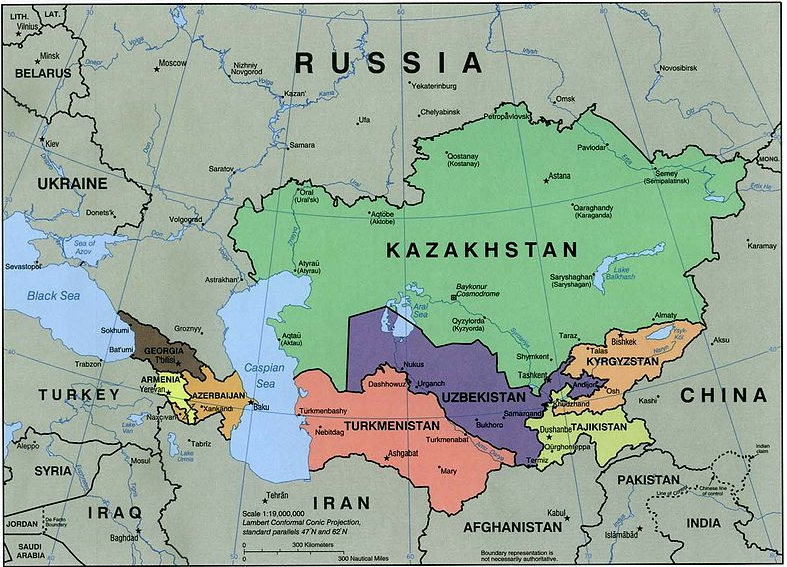With the Kremlin Cat Away, So To Speak, Central Asian Mice Start To Play
It’s not your grandmother’s region, as Communist China makes inroads at the expense of Russia.

While President Putin enjoyed a red carpet reception at Beijing last month, Communist Chinese diplomats quietly worked behind the scenes on a rail project designed to undermine Russian influence in Central Asia, Moscow’s turf for 150 years.
Ignored outside the region, Kyrgyzstan’s Parliament last week ratified construction of a 324-mile, $8 billion east-west railroad designed to bypass Russia’s Trans-Siberian Railway. This October, work is to start on the China-Kyrgyzstan-Uzbekistan railroad.
The line will climb to 12,310 feet to Kyrgyzstan’s Torugart pass, an ancient caravan track through Tian Shan mountains. This will make it the second highest railroad in Asia, after China’s Qinghai-Tibet railway. Compared to the Trans-Siberian, the new, China-funded line will cut 560 miles and eight days off shipping times for Chinese cargo to Europe.

The new railway will create “the shortest land route between the two economic centers of the Eurasian continent along the Middle Corridor,” Beijing’s China Daily rhapsodized about what will be a 51 percent Chinese-owned line. “Developing an additional rail transport route between China and Europe, this time through Central Asia, the Caspian Sea, and the South Caucasus, will be economically feasible.”
At Beijing last month, President Xi greeted his Russian guest with 21-gun salutes and toasts to a “new era.” To the disappointment of the Russians, however, he declined to commit to building the $11 billion Power of Siberia 2 gas line. Russia desperately needs this pipeline to make up for European markets lost due to the war in Ukraine.
While the Ukraine war sucks up Russian men, money, and matériel, Moscow’s distractions are greater than last Sunday’s deadly Islamic terror attack in Dagestan, Russia’s southernmost republic. In the five former Soviet republics of Central Asia, Russia is quietly losing to the People’s Republic of China.
In a sign of the times, President Kasym-Jomart Tokayev of Kazakhstan delivered in October a telling snub. On a visit to Beijing, a former Soviet diplomat, Mr. Tokayev, greeted Mr. Xi in fluent Chinese. The next month, on greeting Mr. Putin at Astana, the Kazakh leader, a fluent Russian speaker, made initial, televised remarks in Kazakh.
Adding insult to injury, Mr. Putin’s visit coincided with the start of a trial of several ethnic Russians who allegedly sought secession for Kazakhstan’s ethnic Russian northern tier.
For imperial nostalgists, this is not your grandmother’s — or babushka’s — Central Asia. The two oil-rich republics, Kazakhstan and Turkmenistan, now have per capita incomes of $14,300, which is higher than Russia’s $13,320. In the Caspian Sea, long seen as a Russian lake, Kazakhstan and Azerbaijan are building navies that rival Russia’s Caspian Flotilla, a fleet depleted by the war in Ukraine.
On a cultural level, Kazakhstan and Uzbekistan are joining Azerbaijan and Turkmenistan in phasing out Russia’s Cyrillic alphabet in favor of Latin letters. In the 1940s, Cyrillic was imposed by the Soviets to distance Central Asia from the Turkic Muslim world. By 2030, 80 percent of Central Asia’s 75 million people will write their languages in Latin script.
Central Asia’s re-orientation toward Turkey and now China contributes to the general contraction of the Russian language since the collapse of the Soviet Union in 1991. A scholar at the Moscow Institute of Sociology, Aleksandr Arefyev, says that the number of Russian speakers worldwide will have plunged to 215 million in 2025, down by one third from 321 million in 1990.
The changes can be seen in Tajikistan, the poorest of the five Central Asian republics. Although highly dependent on remittances from working migrants from Russia, Tajikistan has reviewed 12,500 place names for evidence that they were imposed by Czarist or Soviet colonial authorities. Russia’s news agency, TASS, reports that Tajik names are to be chosen for 802 cities and towns and more than 3,000 mountains and glaciers.
Two Russian culture specialists, Elena Khlyshecheva and Valentina Tikhonova, argue in a recent Russian Foreign Ministry journal that Central Asian nations are creating national identities by using “cancel culture” to deny 150 years of coexistence with Russia. In a countermove, Russia increasingly seeks to insert its narratives into the Kazakh-language press.
On the military side, Russia has two bases in Tajikistan, including one at Bokhtar, 55 miles north of the Afghan border. Despite that presence, China recently opened two bases in Tajikistan. Last fall, China and Tajikistan signed a five-year agreement for bilateral training exercises.
“Regardless of Moscow’s dismissive comments, China clearly aspires to displace Russia as the paramount power in Central Asia and sees the weak regime at Dushanbe as offering it the best chance to do so, especially as China’s anti-terrorism role does not attract the attention from other powers concerned about Afghanistan’s Taliban,” post-Soviet analyst Paul A. Goble writes for his Windows on Eurasia news service.
In Kazakhstan, Central Asia’s largest and richest nation, Communist China has displaced Russia as its top trading partner. Last year, bilateral trade hit $41 billion. This year, China is to become the largest buyer of uranium from Kazakhstan.
This relationship emboldened President Tokayev to tell the Russians that he will follow Western sanctions against Russia and will not recognize Russian sovereignty over conquered Ukrainian lands. Kazakhstan has taken in tens of thousands of Russia draft evaders, hosted anti-war demonstrations, and taken in 4,000 Russian companies in a tidal wave sometimes called a “brain gain.”
Further enraging Russia’s rulers, Kazakhstan follows modern Ukraine’s lead in labelling the 1931-33 Kazakh famine, or Asharshylyk, as a Soviet-designed genocide. Almost half of Kazakhstan’s ethnic Kazakh population died of hunger during that period.
In addition, six months ago, Kazakhstan’s State Commission for the Final Rehabilitation of Victims of Political Repressions rehabilitated all anti-Soviet fighters — the 30,000 Basmachi fighters from the years between 1916 and 1934 and the Turkistanische Legion, the 16,000 Turkic Red Army prisoners of war who fought alongside the Nazis against the Soviets.
Kremlin commentators greet all this with dismay. A former Russian president, Dmitry Medvedev, posted on social media that Kazakhstan is an “artificial state.” Pro-Kremlin journalist Dmitry Steshin wrote on the Komsomolskaya Pravda news site that Moscow has a “historical right” to seize northern Kazakhstan.
Looking at the most impoverished countries of Central Asia — Kyrgyzstan, Tajikistan and Uzbekistan — Russian nationalist politician Zakhar Prilepin said: “These territories, where migrant workers come to us from, should just be annexed to teach them the Russian language there.” Similarly, the vice speaker of the Russian Duma, Petr Tolstoy, says that former Soviet republics whose citizens want to work in Russia must make Russian a state language.
To this, China’s Xi warns: There is a new sheriff in town. Speaking last year at the first China-Central Asia Summit, China’s president gave a guarantee of sorts to the five presidents of Central Asia, saying: “The sovereignty, security, independence, and territorial integrity of Central Asian countries must be upheld.”
A Peking University professor, Feng Yujun, wrote recently in the Economist that “The war has convinced more and more former Soviet republics that Russia’s imperial ambition threatens their independence, sovereignty and territorial integrity. Increasingly aware that a Russian victory is out of the question, these states are distancing themselves from Moscow in different ways.”

